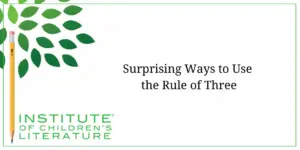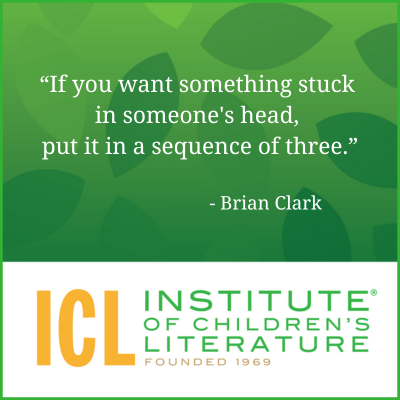
5 Ways Writers Can Prep for 2025 Goal Setting
Before we roll on to the new writing year, let’s harness our optimism for the blank slate before us and prepare for our 2025 Goal Setting just for writers.

This month, we’ve already touched on the rule of three and how the human brain is drawn to things presented in groups of three. Mostly we thought about this as a method of engaging the reader in our writing, the rule of three can be useful beyond manuscript creation. In fact, the rule of three can be helpful in some of the hardest things writers undertake. Let’s look at the rule of three in some unexpected applications: creating engaging titles, query letters, and cover letters.

The very first bit of bait we offer an agent or publisher is the title of the book, article, or story we have to offer. All sorts of things can be used to make a title more tempting. We can make it musical through alliteration or surprising through onomatopoeia. But one of the things that makes a title memorable is the use of the rule of three.
Remember that groups of three tend to stick in our heads because of the way we’re wired. Think about The Lion, The Witch, and the Wardrobe. Not only does this title make use of the rule of three, but it groups three such incongruous items that the reader has no trouble remembering it.
The rule of three in a title doesn’t have to mean an ordering of three things. It also means a title made of three words, whatever words you choose, will tend to be memorable. You’ll see this in the title of many well-known books. Examples include Brown Girl Dreaming, Winnie the Pooh, Number the Stars, and Dragons Love Tacos. Even simple titles in the pattern The-Something-Something use the rule of three and they abound: The Boxcar Children, The Little Prince, The Secret Garden, The Giving Tree. The rule of three in titles isn’t just something you find in older books. Modern children’s writers are still finding three-word titles grab attention with books like Strut, Baby, Strut by Amika Kroll, Finding My Dance by Ria Thunder, I am Enough by Grace Byers, Daddy Speaks Love by Leah Henderson, and Today is Different by Doua Moua.
Of course, there are plenty of titles that don’t use the rule of three. There are even incredibly long titles for books that become classics like Alexander and the Terrible, Horrible, No Good, Very Bad Day by Judith Viorst. But consider how much of a risk a title like that is. It’s become a book almost every children’s writer knows about, but it can be a struggle to get right when searching for or asking for the book, even for fans of the book. Much like Alexander himself, it’s a title that goes its own way, even if that way might be tough sometimes. For Voirst, it was more important that the title reflect the experience and the voice of the main character, and that certainly turned out well.
The rule of three can help you craft a memorable title, but shouldn’t be seen as the only way to do it. Still, it’s a possible choice with the benefit of making your title easier to remember, so it is worth considering.
Successful cover letters and query letters tend to lean heavily into the rule of three. These letters work best if they are only one page long, but within that page, most are divided into topical thirds.
Often the opening part of the letter makes a connection with the reader. It may mention a time you met the agent or editor. It may mention your favorite book from their line, or how often you encountered their books in the classroom. It may mention an article you read about the publisher. This moment of connection helps the agent or editor think better of you because it makes the letter specific and personal.
A connection paragraph proves this is not a letter you are shot-gunning to everyone. This is a letter you crafted specifically for this publisher or agent. In this introduction area, you’ll usually mention the manuscript you have to offer, but you’ll do it in a way that strengthens the connection. Here are a few possible examples:
When I read an article about exciting new agents in Publisher’s Weekly, your quote about loving a good scare immediately interested me, because I have written a middle grade novel, “Spook Attack,” that offers a good scare and more than a few chuckles.
After sitting in on your online workshop for SCBWI and hearing of BookHouse’s passion for own voices and social justice, I knew I had to send my young adult historical novel manuscript, “Tears, Fears and The Journey to Healing,” to you. It’s based on the story of my Lakota great-grandfather’s time spent in a Quaker-run Indian Boarding School.

Even the part of the introductory paragraph that mentions your book will also do three things. It will tell the age group targeted, the type of book, and the title. In the examples above, one of the books was a middle grade novel and the other was young adult (thus age group). One was humor/horror and the other was historical fiction. And the second title even used the rule of three in the title structure.
The second part of any query or cover letter will dive deeper into the piece you are offering. You’ve already given the title, the age group, and the type of book. Now you’ll explore the book more deeply. This is done through a synopsis. In fiction, it explains what the story is about by giving the bare bones of the plot including the inner and outer conflict.
In my chapter book Ghost Light Burning, Jack and his single-parent dad love one another, but they move often and the relationship is strained as a result, especially since Jack’s dad often takes low-paying jobs that demand he work long hours. In this novel, the dad thinks he may have finally landed a good job, especially as it comes with a place to live. He’s the caretaker of a rundown theater, a haunted rundown theater. The conflicts of the story are both personal (Jack’s relationship with his dad) and situational (a ghost). To write a good synopsis, I need to introduce the main character and explain the plot very briefly, giving both internal/personal conflict and external/situational conflict.
Here’s one possible synopsis:

As you can see from this synopsis, the middle of a query or cover letter uses the rule of three as well. First, it deepens our understanding of the main character by giving more details about him. Second, it tells us how the story is affecting the boy emotionally. Notice I didn’t use emotional telling even in this brief synopsis. Instead, I use voice and word choice to give a sense of how Jack feels.
The closest I come to emotional telling is saying the theater is another lonely place, though the implication is that Jack is lonely. Third, the synopsis reveals the main, external conflict. There’s a ghost. It wants Jack to do something and the results of failure could be deadly. This second, external conflict needs to be a doozy to grab the editor’s attention, so I make sure the stakes are impressive.
If you’re sending a cover letter, you really want to keep your chewy center down to something not much longer than the sample above. After all, you’re only whetting the appetite for the story and the story is included with the submission. But if you’re sending a query, where the story will not be attached, you may need to add more details to give the editor or agent a real picture of what you’re offering. Most editors and agents say they also want to know how the book ends, but you don’t have to give a ton of details to do that. Instead, you only need to make it clear what will come out of the story.
For example, in Jack’s story, I could share the ending by adding a single line: “Though Jack and his dad get a happy ending, the journey to get there is bumpy indeed.” Another way to say it might be “Jack saves the day and his dad through quick thinking, courage, and a little help from a new friend.” In the second ending description, I demonstrate not just the external conflict ending with Jack saving the day, but I also hint at the internal conflict of Jack’s loneliness ending through the help of a new friend.
Equally, if I wanted to hint at the internal conflicts with his dad ending, I might choose to use a quote from the story to help the editor see. For example:
“Don’t worry. When we work together we can do anything!” His dad’s false cheer and the clap on the back doesn’t fool nine-year-old Jack Watson. The Dareville Community Theater is just another lonely, rundown place to live while his dad spends all his time working this crummy caretaker job. But things are much worse than Jack knows. The theater is haunted and the ghost won’t let Jack rest until he solves the mystery of the ghost’s murder. And this ghost is anything but patient. Jack will need to convince his dad that the ghost is real before this haunting proves to be the death of them both.
In this, I don’t directly say how it ends, but it’s there. It ends with success because Jack and his dad work together. The quote already told us. When they work together, they can do anything. Jack considers the quote something hokey his dad says, but clearly, he comes to believe it. And once he gets his dad on board about the haunting, that quote reveals how they get their happy ending.
So, when an editor or agent says the query has to reveal the ending, they don’t necessarily mean it has to reveal the specifics. The agent or editor wants to see that the ending comes logically from the story you are telling. So do that, and you’ve revealed the ending.
The synopsis for a nonfiction book will reveal the focus of the book and how it is organized. For example, suppose I am offering a book on the history of peanut butter. In the United States, peanut butter is ubiquitous (even with the increase in peanut allergies in children), but that’s not true in the rest of the world. What made the United States so peanut butter crazy?

This would be a nonfiction story so it would follow a chronology and have characters in the various people who worked on the formula for peanut butter. It would even have conflict as the peanut butter wars grew fairly tense for a time. And the “story” of peanut butter would end in the present day with peanut butter joined by all the other butters out there (even soy and sunflower) but remaining the king. The synopsis for this kind of narrative nonfiction synopsis is usually a little longer than my synopsis for Jack’s story above. Consider the following:
The people of the United States eat about 700 million pounds of peanut butter every year. That’s enough to completely cover the floor of the Grand Canyon. The United States is the world’s biggest peanut butter consumer, by far. But peanut butter hasn’t always been so popular. In fact, it wasn’t mass-produced until the 1920s. My narrative nonfiction book, “The Tale of a Peanut,” chronicles this lowly legume’s journey to popularity, which includes innovation and controversy, heroes and villains, and soldiers and schoolchildren. It’s a journey worth taking, and you’ll never look at a PB&J quite the same.
I would include a specific outline for the book along with this cover or query letter so the editor would be able to see exactly how I would organize and present the story, but the letter would include enough to make it clear what sort of nonfiction I’m offering and the basics of how it’s presented.
The end of a query or cover letter, this third part of the rule of three, contains all the wrap-up parts you need to give the editor or agent. The rule of three pops up (surprise!) since this portion of the letter gives a super brief bit about you and the story, a super brief bit about you as a writer, and a closing hope for the manuscript. For example, the ending portion of the peanut butter story might sound something like this:
My interest in peanut butter came from the clash of my own nostalgic associations with peanut butter and my daughter’s peanut allergy. I found myself spending a lot of time learning about this unique product. And because I’m a writer and researcher with articles in magazines including Cricket, Highlights, and Fun for Kids and nonfiction chapter books for the educational market, I quickly found a fascinating story in the history of peanut butter. I believe you’ll find it engaging as well. May I send you “The Tale of a Peanut?”
In this ending, I explain why I wrote this while also introducing my credentials as a writer and end with my hope for the manuscript (namely that the editor or agent will want to see it). In a cover letter, I would change that last bit to “I believe you’ll find it just as engaging and look forward to hearing from you about it.” This brings a nice sense of closure to the letter.
I will admit I don’t think about the rule of three every moment that I write. In fact, it’s such a part of how our brains work that I’m often making use of it when I don’t know I’m making use of it. But whenever I feel my query or cover letter isn’t quite working or feels unbalanced, I often find the rule of three helps me find the problem and solve it. And whenever I’m searching for a catchy title, the rule of three is always there to lend a hand.
With over 100 books in publication, Jan Fields writes both chapter books for children and mystery novels for adults. She’s also known for a variety of experiences teaching writing, from one session SCBWI events to lengthier Highlights Foundation workshops to these blog posts for the Institute of Children’s Literature. As a former ICL instructor, Jan enjoys equipping writers for success in whatever way she can.

Before we roll on to the new writing year, let’s harness our optimism for the blank slate before us and prepare for our 2025 Goal Setting just for writers.

Writers can be thin-skinned when it comes to getting feedback on their work. Let’s look at 4 ways to positively deal with constructive criticism!

Rejection is part of the territory when it comes to being a writer. Today we offer reflection for writers to help redirect your efforts after a rejection.
1000 N. West Street #1200, Wilmington, DE 19801
© 2024 Direct Learning Systems, Inc. All rights reserved.
1000 N. West Street #1200, Wilmington, DE 19801
© 2024 Direct Learning Systems, Inc. All rights reserved.
1000 N. West Street #1200, Wilmington, DE 19801
© 2024 Direct Learning Systems, Inc. All rights reserved.
1000 N. West Street #1200, Wilmington, DE 19801
© 2025 Direct Learning Systems, Inc. All rights reserved.
1000 N. West Street #1200, Wilmington, DE 19801
©2025 Direct Learning Systems, Inc. All rights reserved. Privacy Policy.
1 Comment
The Rule of Three is great to use in my copywriting business as well. It definitely helps to chunk benefits and features of whatever I’m marketing and makes it more memorable for the consumer. Thanks for this refresh of the rule and how it relates to helping writers to be published.